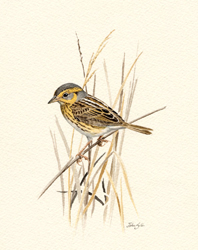Breeding Bird Atlases (BBA)
Find a Bird - BBA1
Breeding Bird Atlas 1 Species Accounts
Saltmarsh Sharp-tailed Sparrow
Ammodramus caudacutus
Egg Dates
May 24 to July 14
Number of Broods
one; may renest if first attempt fails.

The Saltmarsh Sharp-tailed Sparrow is a locally common summer breeding resident of Massachusetts, where it is strictly confined to the immediate coastline. Because it nests exclusively in salt marshes, its distribution along the coast is discontinuous as a result of the presence of sandy beaches, rocky shores, and human intrusions, such as harbor dredging and the presence of marinas. Furthermore, wetland disturbances over three and a half centuries have eliminated many salt marshes where colonies of sharp-tailed sparrows were once documented. In some areas, nesting habitat may be only a few hundred yards in width along the shore, but in other places it may follow estuaries and inlets a short distance inland. Such a limited distribution results in the species being little known to most people and very vulnerable to habitat alteration.
Though there are a few earlier stragglers, most migrant Saltmarsh Sharp-tailed Sparrows arrive during the last week in May. Nesting starts almost immediately in the wide, flat swales of the soft green Salt-hay. Even in pure stands of Salt-hay, the birds are not ubiquitous because they tend to form loose colonies while ignoring apparently identical areas in between. At Plum Island, Barnstable, Monomoy, and Dartmouth, colonies consisted of 3 to 15 pairs, with 1 to 1.5 pairs per acre, and colonies were .5 to 1 mile apart (ACB).
There is little or no courtship behavior prior to nesting. The song consists only of a buzzing hiss preceded or followed by several sharp notes: gshshhh swik wick. The nests are neat, cup-shaped structures composed of fine grasses and are about 3 inches in diameter. They may be placed on the ground, tucked under tufts of grass, often with a short runway as an entrance, or may be several inches up in stems. Seven nests in Revere were located as follows: 1 on the ground in a clump of rushes, 1 on the ground in sedges (covered from above), and 5 from 1 to 4 inches up in sedge stems. In Falmouth, nests were 2 to 3 inches up in grasses, and in Barnstable nests were in Salt-hay 2 to 3 inches up and shielded from above by dead grass (ACB). Seven state nests from another sample were located as follows: Salt-grass (2 nests), sandy area in grass (2 nests), Bayberry (3 nests). Four of these nests were on the ground, 1 was at a height of 6 inches, and 2 were at a height of 1 foot (CNR).
Typical clutches consist of three to five eggs. Clutch sizes for 5 state nests were three eggs (2 nests), four eggs (3 nests) (CNR, ACB). Egg dates range from late May to early July, and later ones probably represent second nesting attempts because the species is believed generally to be single brooded in this state. Incubation lasts 11 days and is performed entirely by the female; the males are promiscuous and roam over the ranges of several females. Nestlings have been reported in Massachusetts from June 9 to August 2 (ACB, CNR). Brood sizes for 7 state nests were one young (1 nest), three young (3 nests), four young (3 nests) (CNR, ACB, BOEM). The young fledge in 10 days and continue to receive some parental feeding for the next 20 days. State fledglings have been reported from June 19 to early August (ACB, CNR), and by early July the marshes literally swarm with them in their rich buff body plumage with dark crown, wings, and tail, so different from the adults that they could be mistaken for a different species. The young are fed chiefly on insects, although the adults take some vegetable matter, especially in winter. Outcomes for seven state nests were young fledged (3 nests), destroyed by high tides (2 nests), unknown (2 nests) (CNR).
The young undergo a molt in September and October. Adults molt after nesting and also have a prenuptial molt. By mid-September, the birds gradually unobtrusively withdraw southward, and the leisurely departure lasts into November. After that a few stragglers may be recorded on Christmas Bird Counts in the southeastern part of the state, but it is not known whether any survive the winter.
Though, as noted, our breeding sharp-tails are confined to coastal salt marshes, mention should be made of the Nelson’s Sharp-tailed Sparrow, which, although it never breeds here, does migrate through and may be found either along the shore or occasionally in inland freshwater marshes.
Map Legend and Data Summary
Atlas 1 data collected from 1975-1979


Note: locally common in salt marshes
Norman P. Hill



